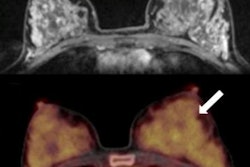
PET imaging tracers that track breast cancer enzymes could help guide treatment of the disease, especially in women with BRCA mutations and triple-negative subtypes of cancer, according to two studies presented this week at the 2018 San Antonio Breast Cancer Symposium (SABCS).
In the first study, Dr. Elizabeth McDonald, PhD, of the University of Pennsylvania and colleagues used PET imaging and a radiotracer called F-18 fluorthanatrace (FTT) to measure levels of the enzyme poly (ADP-ribose) polymerase-1 (PARP-1) in 30 women with breast cancer with various subtypes before therapy, including surgery. Some breast cancer patients with BRCA mutations are treated with PARP inhibitors because cancer cells rely on PARP-1 to survive; FTT binds to PARP-1 to make it visible on PET imaging, McDonald's group wrote.
The researchers correlated FTT uptake in the breast cancer patients with surgical breast cancer specimens that had been stained for PARP-1 in the lab. They found that the agent effectively visualized and measured PARP-1 levels in all breast cancer tumors and metastases.
"This study provides early validation of FTT as a quantitative method to measure PARP-1 expression in breast cancer," McDonald said in a statement released by the university.
In the second study, another set of researchers from the University of Pennsylvania used F-18 fluciclovine with PET imaging to measure tumor glutamine levels in mouse models of breast cancer. Some triple-negative breast cancers rely on glutamine for survival and growth, according to a team led by senior author Rong Zhou, PhD.
The U.S. Food and Drug Administration (FDA) has approved the use of PET with fluciclovine for prostate cancer imaging, but its utility with other cancers is unclear, Zhou and colleagues noted. The group showed that fluciclovine-PET was effective in tracking the change of tumor glutamine level in response to glutaminase inhibition.
Using fluciclovine-PET in this way could offer a noninvasive alternative for detecting early response to chemotherapy for breast cancer, the researchers concluded.
"These studies are important steps toward developing much-needed, noninvasive imaging tests to help measure and predict inhibitor responses and guide treatments for women with a wide range of breast cancers," study co-author Dr. David Mankoff, PhD, said in a statement released by the university.





















